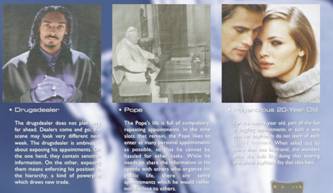Reader comments
John Sorflaten
SAIC
Thanks, Apala for this inspiring review. Good "characters" are good not because they are "good", but because they are memorable. This is what extreme personas offer. It's food for the imagination. But...as you point out, even the extreme character has needs with which we can all identify. So--what we just learned, is that the character is not the message. It's their needs and goals that are the message. The character is the vehicle...and we all like snazzy vehicles that feed our imagination.
Karl Mochel
Whenever I've seen personas used the details tend to get in the way more than be useful. It's useful to think that one set of users have no SQL experience, another set is willing to edit and another is comfortable creating from scratch. It is not useful or relevant what they wear, where they are from or what they think of super heroes. The first set of traits can be designed against because it is a meaningful distinction between sets of people. The latter are personal and not likely to reflect an realistic difference across any spectrum of users let alone in the context of a particular design. I would say in fact that they detract from helping us design, because their specificity blinds us to to the variety of ways different likes/dislikes/interests interplay across a population.
Maral Haar
I am working in the research unit of a company developing medical devices and safety equipment. In comparison to the PDA example, our users are experts in their domains and have a high knowledge we (as developers) don't have. Even though some of us are experts in certain clinical (or safety) areas, e.g., ventilation of patients, our perspective is completely different than the perspective of the user. We do even have project managers and developers who have been firefighters or nurses themselves, but still they are not very representative for "the users", and they can't be involved in every project.
For me it is hard to get a basic understanding of the work, the domain, the tasks, goals and processes at all, and personas help me to conclude what I observe or learn when I visit users at their workplaces. Probably our personas lack the juice mentioned above, but I still find them very valuable because, compared to consumer electronics (like PDAs) or websites, we can't start based on our own experiences and expectations. Our personas include goals, tasks, typical problems, traits and attitudes as we observed them, and they are much more complex than the Jane example. Still they lack the "juice", and I am not sure we will ever include such strong "additional" diversity, as we have more diversity in the users we observe than we wish for. At the moment our goal is rather to reduce the number of our personas, and find more common bases than to add extremes.
Dave Fondacaro, Pitney Bowes
The content of the persona should reflect the relevant characteristics of the audience you're designing for, and in some cases the audience you're not designing for (negative personas). If you're designing BtoB productivity software then the examples you cite are relevant (SQL experience, etc). Basically, in the BtoB world personas should include information about the work the person does. If however you're designing consumer products and/or marketing materials for consumer products, then personal information is very important. If you're going to appeal to the desires and emotions of a market segment, then you may very well want to know what they wear, where they are from, what they think of superheroes, and yes, whether or not they have a cat. I have seen personas fail to add value and I've seen them work very well. It boils down to the skill of the UX designer in understanding what the relevant information is to include in the personas.
I hear what you're saying though, too often in the BtoB world I've seen personas with information about the car that Peter drives, or the fact that he has two kids in college. That info doesn't add value and can actually be quite a turn-off to the people it's supposed to enlighten. Keep your personas short and include only relevant information or they won't be adopted by the broader team.
Ethan
I fail to see how any of the ostensibly "bad boy" personas complete a niche left vacant by Schaffer's so-called safe personas other than they're perhaps somewhat more piquant.
How does a drug dealer differ from your prototypical Wall Street global investment banker; uncertain the difference is that great. Same with the Pope, how is he any different than any other publicly notable high net worth individual who enjoys playing power games with his staff?
In all, the need to develop 'extreme' persona strikes me as off key as it cements in the mind of product and service developers and providers the notion that people are in any way categorizable insofar as a minority of their traits are concerned when set against a spectrum of socially acceptable traits and desires.
Nishita
Thank you Apala, I really enjoyed reading this article. In my opinion design is in the details. and when you have a well fleshed out persona, the chances of creating unique designs that pay attention to detail is much higher. I do agree of course, that it does boil down to the skill of the UX designer and the way he extracts or processes this data from the personas is equally important.



